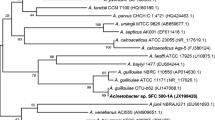Abstract
The effects of metal ions on the biodegradation of benzene and toluene were investigated. Among 12 tested metal ions, Cu2+, Ni2+, Co2+ and A+ g inhibited the degradation of benzene and toluene severely byAlcaligenes xylosaxidans Y234. Cu2+ was found to inhibit catechol 1,2-dioxygenase in the degradation of benzene and toluene. Co2+ and Ni2+ were supposed to inhibit benzoate 1,2-dioxygenase, while Ag+ was supposed to inhibit benzaldehyde dehydrogenase in the degradation of toluene. The inhibition effect caused by these metal ions could be overcome both by microbial adaptation and by adding specific aromatic compounds to the broth.
Similar content being viewed by others
References
Alexander, M.,“Biodegradation and Bioremediation”, Academic Press, New York, 196 (1994).
Alvarez, P. J. J. and Vogel, T. M.,“Substrate Interactions of Benzene, Toluene, and para-Xylene during Microbial Degradation by Pure Cultures and Mixed Culture Aquifer Slurries“,Appl. Environ. Microbiol.,57, 2981 (1991).
Arvin, E., Jensen, B. K. and Gundersen, A. T.,“Substrate Interaction during Aerobic Biodegradation of Benzene”,Appl. Environ. Microbiol.,55, 3221 (1989).
Bradford, M. M.,“A Rapid and Sensitive Method for the Quantitation of Microgram Quantities of Protein Utilizing the Principle of Protein-dye Bonding”,Anal Biochem.,72, 248 (1976).
Chang, M. K., Thomas, C. V. and Craig, S. C.,“Kinetics of Competitive Inhibition and Cometabolism in the Biodegradation of Benzene, Toluene, and p-Xylene by Two Pseudomonas Isolates”,Biotechol. Bioeng.,41, 1057 (1993).
Chun, W. K. and Genthner, B. R. S.,“Effect of Added Heavy Metal Ions on Biotransformation and Biodegradation of 2-Chlorophenol and 3-Chlorobenzoate in Anaerobic Bacterial Consortia”,Appl. Environ. Microbiol.,62, 2317 (1996).
Duetz, W. A., de Jong, C., Williams, P. A. and VAN Andel, J. G.,“Competition in Chemostat Culture between Pseudomonas Strains That Use Different Pathways for the Degradation of Toluene”,Appl. Environ. Microbiol.,60, 2858 (1994).
Gadd, G. M. and Griffiths, A. J.,“Microorganisms and Heavy Metals”,Microb. Ecol.,4, 303 (1978).
Gibson, D. T., Koch, J. R. and Kallio, R. E.,“Oxidative Degradation of Aromatic Hydrocarbons by Microorganisms. I. Enzymatic Formation of Catechol from Benzene”,Biochem.,7, 2653 (1968).
Gottschalk, G.,“Bacterial Metabolism”, 2nd ed., Springer-Verlag, New York,1 (1985).
Hamzah, R. Y. and Al-Baharna, B. S.,“Catechol Ring-cleavage in Pseudomonas cepacia: the Simultaneous Induction of Ortho and Meta Pathways”,Appl. Microbiol. Biotechnol.,41, 250 (1994).
Hughes, M. N. and Poole, R. K.,“Metals and Micro-organisms”, Chapman and Hall, London, 204 (1989).
Lee, J. Y., Jung, K. H., Choi, S. H. and Kim, H. S.,“Combination of the Tod and Tol Pathways in Redesigning a Metabolic Route of Pseudomonas putida for the Mineralization of a Benzene, Toluene, and p-Xylene Mixture”,Appl. Environ. Microbiol.,61, 2211 (1995).
Nakazawa, T. and Nakazawa, A.,“Pyrocatechase (Psueudomonas)”,Method in Enzyme,17A, 518 (1970).
Nazaki, M.,“Metapyrocatechase (Pseudomonas)”,Method in Enzyme,17A, 522 (1970).
Oh, Y. S., Shareefdeen, Z., Basil, C. B. and Richared, B.,“Interactions between Benzene, Toluene, and p-xylene (BTX) during Their Biodegradation”,Biotechnol. Bioeng.,44, 533 (1994).
Satsangee, R. and Ghosh, P.,“Anaerobic Degradation of Phenol Using an Acclimated Mixed Culture”,Appl. Microbiol Biotechnol,34, 127 (1990).
Waite, J. H. and Tanzer, M. L.,“Specific Colorimetric Detection of o-Diphenols and 3,4-Dihydroxyphenylalanine-Containing Peptides”,Anal. Biochem.,111, 131 (1981).
Yeh, W. K, Gibson, D. T. and Liu, T. N.,“Toluene Dioxygenase: A Multicomponent Enzyeme System”,Biochem and Biophysical Research Comm.,78, 401 (1977).
Yeom, S. J., Kim, S. H., Yoo, Y. J. and Yoo, I. S.,“Microbial Adaptation in the-Degradation of Phenol byAlcaligenes xylosoxidans Y234”,Korean J. of Chem. Eng.,14, 1 (1997).
Zylstra, G. J. and Gibson, D. T.,“Aromatic Hydrocarbon Degradation: A Molecular Approach, Genetic Engineering”, Plenum Press, New York, 183 (1991).
Author information
Authors and Affiliations
Rights and permissions
About this article
Cite this article
Yeom, S.H., Yoo, Y.J. Overcoming the inhibition effects of metal ions in the degradation of benzene and toluene byalcaligenes xylosoxidans y234 . Korean J. Chem. Eng. 14, 204–208 (1997). https://doi.org/10.1007/BF02706096
Received:
Accepted:
Issue Date:
DOI: https://doi.org/10.1007/BF02706096




